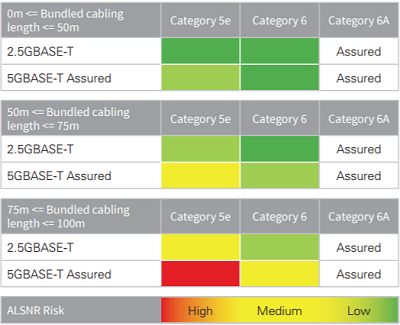Will My Existing Cable Plant Support 2.5/5GBASE-T?
January 17, 2018 / Standard and Certification
Driven by the NBASE-T Alliance and compatible with the NBASE-T specification, IEEE 802.3bz specifies 2.5 Gbps over 100 meters of Category 5e cabling or 5 Gbps over 100 meters of Category 6 cabling. It also includes support for 5 Gbps over Category 5e on defined use cases (extended frequencies).
2.5/5GBASE-T was primarily introduced to support 802.11ac Wi-Fi devices over the installed base of Category 5e and 6, and now that active equipment is out in the marketplace, many enterprise businesses are looking to deploy this technology and reap the benefits of faster Wi-Fi without a cabling upgrade.
But not all cabling plants are created equal, and moves, adds and changes over the years can cause physical damage that can impact performance. It’s smart to know if your existing cable plant will support 2.5/5GBASE-T before you invest in the equipment.
The Why and the How
About 80% of the installed base of cabling infrastructures in enterprise LANs consists of Category 5e that operates at 100 MHz or Category 6 cabling that operates at 250 MHz—both of which are typically able to support up to 1000 Mbps. For most enterprise customers, this offers plenty of bandwidth for office applications.
When 802.11ac Wi-Fi was introduced in its first phase (Wave 1), it required gigabit connections, which meant that standards-based Category 6 and Category 5e cabling infrastructures could support these devices. But to support more wireless devices and applications like video streaming over Wi-Fi, speeds in excess of gigabit Ethernet were needed. So the second phase of 802.11ac (Wave 2) hit and doubled the speed.
Extending the life of Category 5e and 6 cabling by enabling support for Wave 2 802.11ac Wi-Fi, the 802.3bz standards is based on 10GBASE-T but reduces the signaling rate to half (for 5GBASE-T) and to a quarter (for 2.5GBASE-T) to fall within the frequencies for Category 6 and Category 5e cabling respectively. It also provides support for PoE, including PoE plus (Type 2) and upcoming four-pair Type 3 PoE, to deliver power to the Wi-Fi access points.
Risk Assessment
While alien crosstalk is a limiting factor in 2.5GBASE-T and 5GBASE-T applications, Category 5e and Category 6 cabling do not include alien crosstalk specifications. Consequently, TIA TSB-5021 and ISO/IEC TR 11801-9904 performance specifications were introduced to address the evaluation of existing Category 5e and 6 cabling for support of these applications. These documents characterize extended frequency for Category 5e performance above 100 MHz (to support 5GBASE-T) and include qualification specifications, including internal cabling parameters (insertion loss, return loss, near-end crosstalk, etc.) and alien crosstalk.
Alien crosstalk performance for support of 2.5/5GBASE-T applications is determined using a formulation called ALSNR, Alien Limited Signal to Noise Ratio. ALSNR combines calculations for insertion loss, alien near-end crosstalk (NEXT) and alien far-end crosstalk (FEXT).
It’s well known that longer, tighter cable bundles exhibit more alien crosstalk, and assessment can be made to determine which channels may be at risk. This assessment can be done by reviewing cabling documentation, previous test results and visual inspections.
This table from the NBASE-T Alliance is a good guide for determining risk—the longer the length of bundled cabling, the higher the ALSNR risk. This is where good documentation comes in handy—test results from the time the cabling plant was deployed can be sorted by length to determine which links are vulnerable. Visual inspection will let you know if these links are tightly bundled.

Mitigation Can Help, Only Testing Will Tell
While most enterprise customers with cabling plants that have been previously certified will likely have little problem supporting 2.5 and 5GBASE-T, testing is really the only way to truly know if your links will work properly. Thankfully, the Fluke Networks’ DSX series of testers includes an option for 2.5 and 5GBASE-T testing—and it can be done in less than ten seconds.
And if the existing Category 5e or Category 6 cabling plant does include long runs of tight bundles that prevent it from passing ALSNR to support 2.5/5GBASE-T, there are some mitigation practices you can try. Unbundle cables, especially patch cables since interfering signal is strongest closest to the transmitter. Another option is to try replacing Category 5e or 6 patch cords with Category 6A or shielded components. You can also limit 2.5/5GBASE-T application to shorter channels (less than 50 meters) or be selective by choosing nonadjacent patch panel ports for your 2.5/5GBASE-T applications.
And if you do need to mitigate, make sure you test again with your DSX tester to confirm support.






